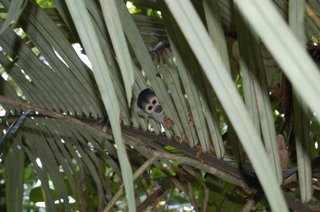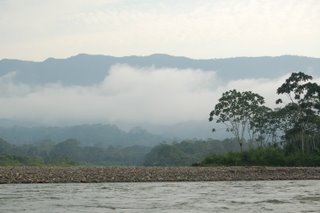Welcome to the jungle
The one thing that we agreed on when we were planning our trip to South America was that we didn´t want to go to the jungle. Although, secretly, I think that we both harboured the idea of a nice eco-lodge in Costa Rica with all the creature comforts, that big green thing to the east of the Andes was supposed to be a no go area. Too many snakes, biting insects and heat.
So, of course, what do we do within 6 hours of arriving in Cusco - we book ourselves on a 9 day trip into the Manu biosphere, leaving the next morning at 4.30 am. Approximately half the area of Switzerland, Manu comprises Andean montane cloud forest, tropical lowland forest and the Alto Madre de Dios and Manu river systems. It is home to over 1000 species of birds, 15,000 species of plants, over 200 species of mammals, and untold numbers of insects, and within its heart remain yet uncontacted peoples.

The jungle road, built by Sven Ericsson (the engineer, not football manager), is just wide enough for a bus and is open to traffic going into the jungle on Mondays, Wednesdays and Fridays, to outgoing traffic on Tuesdays, Thursdays and Saturdays, and to a mad free for all on Sundays, when God presumably determines the outcome. We followed wagons loaded with wood, people, bananas and, no doubt, cocaine from the illicit coca plantations.
After a day and a half on the road, we reached the village of Atalaya and boarded a motorised canoe. There were ten tourists, Tina (the guide), Richard (the boat driver), Cesar (his assistant) and Mariano (the cook). In hot sun and a blue sky, we set off down the muddy brown Alto Madre de Dios (Mother of God) river and Richard steered us between boulder beaches, hundreds of sunken, stranded tree trunks and frothy shallows.
 Within an hour, a storm broke and we huddled under plastic sheets for the next 5 hours, the boredom broken only by a white caiman (a tropical crocodile) sliding into the river and a family of hairy, grey-bearded capybara (giant rodents). Later, we reached our lodge for the night and went out with torches after dark looking for ´interesting things´ by which Tina meant tarantulas! We found a mother and baby under the thatched roof of the shower block - I am not sure that many people showered that night........
Within an hour, a storm broke and we huddled under plastic sheets for the next 5 hours, the boredom broken only by a white caiman (a tropical crocodile) sliding into the river and a family of hairy, grey-bearded capybara (giant rodents). Later, we reached our lodge for the night and went out with torches after dark looking for ´interesting things´ by which Tina meant tarantulas! We found a mother and baby under the thatched roof of the shower block - I am not sure that many people showered that night........Two days later, we were far down river at a clay cliff watching almost 100 red and green macaws (the stereotypical jungle bird - bright rainbow feathers, a long tail and the hooked beak of a parrot) eating the minerals to counter the toxins that they accumulate from eating unripe fruit. Before the macaws ate, hundreds of blue and green parrots flitted at the cliff face like butterflies. We watched the birds for 3 hours until they had finished and I really didn´t want to leave as it is somehing that I don´t think I will ever see again.
With the weather improved in the sense that it was no longer raining (it was still 100% humidity and very, very hot), we headed into the Manu reserve.
 The Manu river meanders with a venegeance and you can often see across the thin spits of land between bends and know that it will take you half an hour in the boat to cover what you could walk in a minute. The consequence of this hugely actve river is that oxbow lakes are created with regularity (3 in the last 10 years). In, and around, these secluded oxbow lakes (some up to 8 km long) can be found incredible wildlife and over two long days, we walked and paddled on floating platforms around these areas of wilderness.
The Manu river meanders with a venegeance and you can often see across the thin spits of land between bends and know that it will take you half an hour in the boat to cover what you could walk in a minute. The consequence of this hugely actve river is that oxbow lakes are created with regularity (3 in the last 10 years). In, and around, these secluded oxbow lakes (some up to 8 km long) can be found incredible wildlife and over two long days, we walked and paddled on floating platforms around these areas of wilderness.The list of wildlife that we saw does not do justice to the excitement of walking through the jungle, hearing something, scanning the vegetation, tree tops and water, and then seeing a movement, a glimpse of colour and finally a bird, monkey or other animal. Statistics invitably reduce these feelings to a simple list, but we saw 8 species of monkey, giant otters, capybara, white and black caiman, tapirs, snakes, a poison dart frog, over a hundred species of birds and the smelly peccary (a type of wild pig).
 It is hard to pick one single experience. It was amazing to stand in the middle of a troop of over 100 foraging squirrel monkeys as they leapt around us. Dancing along branches, jumping gaps from tree to tree and occasionally stopping to look at us, it was like having a storm rush past you. It was a privilege to watch two male tapirs, each weighing 250 kg, charge from the undergrowth and into the river in a territory dispute. The loser swam just behind the canoe to a beach on the other side of the river, shook his stubby tail and trotted into the undergrowth. It was humbling to see three giant otters fishing, calling and swimming in one of the oxbows. The wildlife was quite inspriing and it was impossible not to wonder at the complex connections between all the elements of the rain forest ecosystem.
It is hard to pick one single experience. It was amazing to stand in the middle of a troop of over 100 foraging squirrel monkeys as they leapt around us. Dancing along branches, jumping gaps from tree to tree and occasionally stopping to look at us, it was like having a storm rush past you. It was a privilege to watch two male tapirs, each weighing 250 kg, charge from the undergrowth and into the river in a territory dispute. The loser swam just behind the canoe to a beach on the other side of the river, shook his stubby tail and trotted into the undergrowth. It was humbling to see three giant otters fishing, calling and swimming in one of the oxbows. The wildlife was quite inspriing and it was impossible not to wonder at the complex connections between all the elements of the rain forest ecosystem. We stopped the final night at a lodge where the tourists beat the Peruvian staff at 5-a-side football. I can report that I scored the winner in the dying minutes of daylight. The next day was the simple matter of 3 hours in the canoe and 10 hours in the bus to get back to Cusco.
We stopped the final night at a lodge where the tourists beat the Peruvian staff at 5-a-side football. I can report that I scored the winner in the dying minutes of daylight. The next day was the simple matter of 3 hours in the canoe and 10 hours in the bus to get back to Cusco.There are some experiences that should never be forgotten and the sounds, smells and heat of the jungle will remain with us both for a very long time. I hope they serve to remind us of the areas of our planet that need protecting.


1 Comments:
If they haven't been contacted then how do you know there are uncontacted peoples in Manu?!
Post a Comment
<< Home